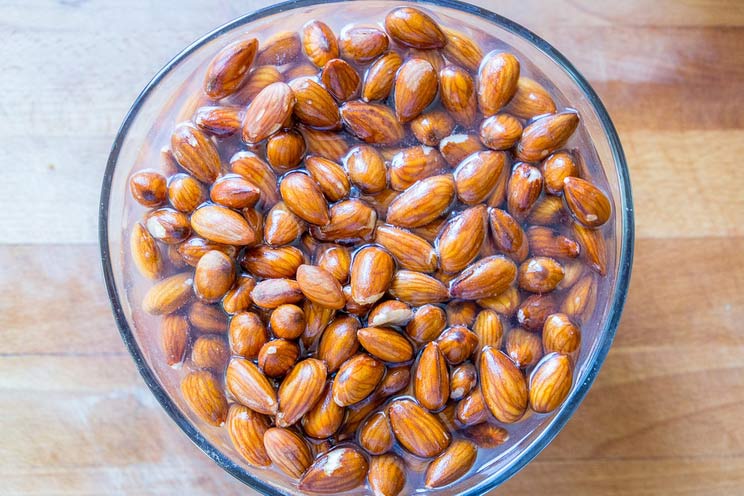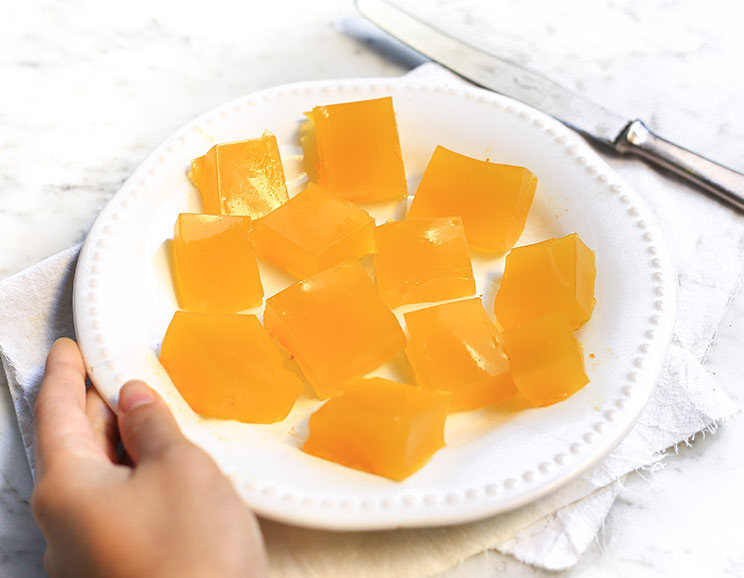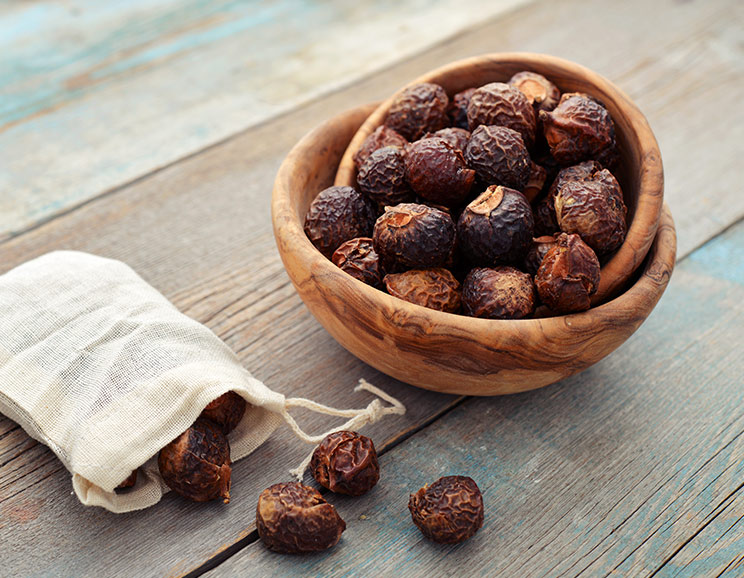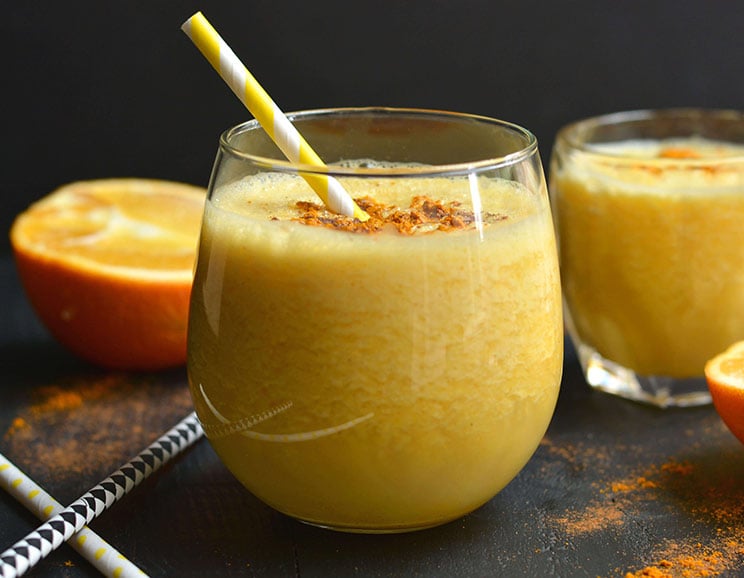If you feel bloated after eating nuts, that’s because they contain some hard-to-digest particles.
The good news is that you can make your own activated nuts get all the good vitamins and minerals – and none of the anti-nutrients. Nuts are an incredibly healthy food and a staple in the Paleo diet. But they also contain compounds referred to as “anti-nutrients”, which can make digestion problematic for some.
When you soak nuts in water before eating them, the anti-nutrient compounds get broken down and neutralize their damaging effects. It also increases nutrient absorption and helps cut down on digestion problems.
Do you struggle with bloating, gas, constipation, or other digestive issues? We’ve created a FREE guide to healing your gut naturally.
Click here to get your FREE copy of our Digestion Guide!
Read on to discover how to soak nuts to “activate” them in this simple how-to guide.
Why Are Soaked Nuts Healthier?

Nuts contain lots of beneficial nutrients, including protein, calcium and fiber and more. Unfortunately, nuts also contain anti-nutrients, which can cause irritation and damage to the human gut. Anti-nutrients exist to protect the plants from natural predators, but they don’t disappear once the plant is harvested and ready for human consumption.
Anti-nutrients are found in nuts, seeds, and grains, and can block enzymes. This leads to digestive problems, because the foods you eat cannot be fully broken down.
Since nuts contain anti-nutrients, the beneficial vitamins, minerals, and macronutrients in them might not be accessible if your body is struggling to digest them. Let’s examine a few types of anti-nutrients more closely.
Lectins
Lectins are a type of plant protein that act as a deterrent to animals in the wild. Humans are also unable to digest lectins, so when they’re eaten in larger amounts, the result can be bloating, flatulence, and other digestive pains. (1)
Soaking reduces lectins in foods, and in some cases removes them entirely. (2) They’re found in the skin of the nut, so when soaked for an appropriate amount of time, they detach from the food and dissolve in the water.
Tannins
Tannins are another anti-nutrient that can block enzyme activity and nutrient absorption, resulting in adverse effects on the digestive system. (3)
Soaking reduces tannins in foods, since they are also found in the skins of foods and dissipate when exposed to a water soak. (4)
Phytates
Also referred to as phytic acid, phytates bind with minerals and nutrients during the digestive process to block bioavailability. This can lead to a deficiency in minerals like iron and calcium. (5) It can also irritate the lining of the gut, leading to inflammation or leaky gut. Almonds, in particular, can have some of the highest phytic acid levels of any plant food.
While small amounts of phytic acid or phytates might not produce symptoms, if your diet heavily relies on nut products, you could be dealing with mineral malabsorption and other gut-related problems.
Soaking nuts, grains, and seeds helps to reduce their phytic acid levels by as much as 98 percent. (6)
3 Benefits of Activated Nuts
When nuts are soaked, they become “activated” as anti-nutrients are blocked. This leads to several health benefits:
- Decreases enzyme inhibitors. By removing anti-nutrients, enzymes are free to function as they’re supposed to, improving natural digestion and absorption.
- Increases availability of nutrients. Without anti-nutrients to bind to them, minerals that are abundant in nuts are able to be fully digested, absorbed, and utilized for health.
- Promotes prebiotic and probiotic growth. The large intestine and colon rely heavily on “good” bacteria to regulate health, keep the immune system balanced, and more. When nuts are activated and free from anti-nutrients, they contain beneficial fiber and nutrients to support gut bacteria.
Specifically, soaking nuts helps to free up specific nutrients they contain that are blocked or inhibited by anti-nutrients. These include vitamins A, C, and the family of B vitamins, which are all essential for antioxidants and a healthy nervous system.
How to Activate Nuts

All nuts contain anti-nutrients, and need to be soaked to dissolve the anti-nutrients attached to the outer layer. However, some nuts are softer than others, and so soak times can vary.
The longer-soak nuts require a few rounds of soaking if you have sensitive digestion or if you want to be sure you’ve removed all anti-nutrients.
If you’re using your soaked nuts for nut milk, you can start with your recipe after they’ve been soaked and rinsed. If you’re using them for baking or other items that require “dry” nuts, you may need to dehydrate the nuts to return them to a normal liquid balance.
To dehydrate soaked nuts, spread on a baking sheet (or a dehydrator). Bake at 150ºF for 24 hours or until fully dried out.
Optimal Soaking Times for Nuts
- Almonds – 12 hours
- Brazil nuts – 3 hours
- Cashews – 4 hours
- Hazelnuts – 12 hours
- Macadamia nuts – 2 hours
- Pecans – 6 hours
- Pistachios – 8 hours
- Walnuts – 4 hours
Activated Nuts: How to Soak Away Hidden Anti-Nutrients


Activated Nuts: How to Soak Away Hidden Anti-Nutrients
- Pitcher
- Glass bowl
- Cheesecloth
- Colander
How to Activate Nuts:
- 4 cups distilled water
- 1 t Celtic sea salt
- 2 cups organic, raw nuts of choice
For Rinse Solution: (optional)
- 5 cups water
- 2 T apple cider vinegar
- In a pitcher, combine 4 cups of water and 1 teaspoon of Celtic sea salt.
- Place the nuts in the glass bowl and cover with the salt water. Cover with a cheesecloth, flour cloth, or anything that is breathable. Do not use plastic wrap or foil.
- Keep the nuts at room temperature while soaking.
- Once the nuts have soaked for the proper amount of time, use a colander to drain the nuts. Discard the water since it contains all of the anti-nutrients that you just removed.
- Rinse the nuts in cold, filtered water or make a rinse solution of 5 cups of water and 2 tablespoons apple cider vinegar. Allow the nuts to sit in the rinse solution for a few minutes, and then rinse with cold, filtered water.
- Discard any nuts that have floated to the top of the water on final rinse, as these haven’t retained water and have either gone bad or still contain anti-nutrients.

(Read This Next: 20 Things You Didn’t Know About Nuts)






 Maple Bacon-Wrapped Wings
Maple Bacon-Wrapped Wings







Show Comments